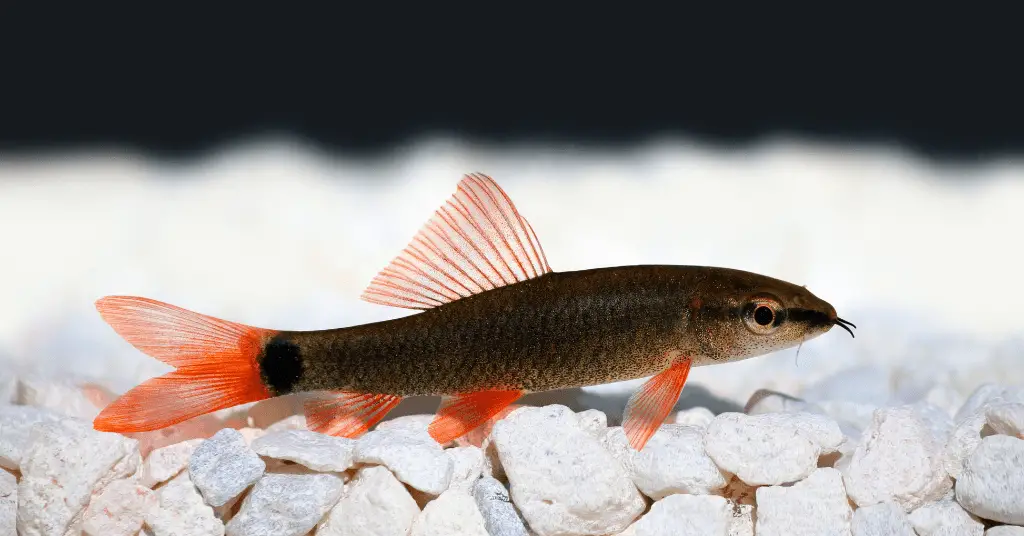Last Updated on July 13, 2022 by cmoarz
Why do my rainbow sharks keep dying? It’s a popular question that gets asked a lot. The simple answer is that they are a very delicate species of fish and require a very specific environment to thrive.
In this article, we’ll go over some of the main reasons why rainbow sharks often don’t do well in captivity and what you can do to keep them healthy and happy.

Why rainbow sharks often die early in their life
Table of Contents
As far as most fish go, Rainbow sharks aren’t the most sensitive species out there.
They are actually pretty hardy as long as their water quality is good and they have plenty of space to swim around.
That being said, there are a few things that can lead to early death in Rainbow sharks.
- They are semi-aggressive and get in fights. If you have a lot of other fish in the tank with your Rainbow shark, there’s a good chance they will get into a fight at some point. Bruising and cuts and other physical damage is the main cause of early death in Rainbow sharks due to infection.
- The water parameters are “healthy” but swing too often. While rainbow sharks aren’t super sensitive to water conditions as other fish, They are sensitive to wild swings in temperature or pH. If they spike or drop too quickly, or fluctuate too often, it can easily kill them.
- Genetic defects are a common issue in rainbow sharks purchased from big chain pet stores. We’ve all had our experiences with getting fish from a large chain store. It’s often a coin toss as to how healthy they can be. Add to that inbreeding and bad care and you get a fish that doesn’t have a long life expectancy, to begin with.
- Bad diet balance. A proper diet is vital to your rainbow sharks’ health. They are omnivorous as well as herbivores, but they’ve been known to be fairly picky. They need a healthy diet of live proteins like tubifex works, crustaceans, etc as well as plant-based algae flakes.
- Bad water parameters. All fish will eventually succumb to bad water parameters. Ammonia, Nitrites, and Nitrates should be at 0. pH should be between 6.0-8.0 Temperature should remain steady at around 78°F (25.5°C).

Stability is key to keeping your rainbow sharks alive
The biggest killer of rainbow sharks is a lack of water stability. If your water quality is constantly changing, or if there are sudden spikes or drops in temperature or pH, it will stress them out and eventually kill them.
The best way to remedy this is to keep your tanks in a climate-controlled room. This will help keep the temperature and humidity stable, which will in turn help keep your water quality more stable.
Get plenty of depth on your substrate for that lovely bacteria surface area, as well as a healthy amount of plant life. This will help with water stability as well as provide a place for your rainbow shark to hide if it gets spooked.
A good filtration system is also key to keeping your water quality high and stable. A canister filter is always a good choice, but make sure you get one that is rated for at least twice the size of your tank.

Treating illness and parasites
If your fish is sick, injured, or has parasites, it will likely not survive for long. That’s why it’s important to catch any illness or parasites early and treat them immediately.
Fighting off infection is step one for any injury or damage. By keeping water clean and stable, you can help prevent infection in the first place. But if your fish does get cut or injured, you’ll need to treat it with an antibiotic.
If your fish has parasites, the first step is to remove them from the tank if shared with other fish and place it in a quarantine tank for treatment.
There’s a good chance if one fish has parasites, they all do, and in that case, you might wish to treat the entire tank instead.
Identify the parasite and treat it accordingly. Common parasites include ich, velvet, flukes, and worms.

Signs a rainbow shark is ill
- Coming to the top to breathe or hanging around the surface.
- Clamped fins
- Lethargy
- Not eating
- Trouble swimming
- White spots on the body or fins (ich)
- Cloudy eyes
- Scratching on rocks or decor
- Stringy poop (indicating parasites)
- A humped back (severe malnutrition)
Keep an eye out for any of these signs. Fish usually don’t just die out of the blue, And some of these signs can be easily remedied if caught early enough.

Bottom line;
Rainbow sharks are beautiful fish that can make a great addition to any aquarium. However, they can be a bit finicky to keep alive. With a little knowledge and care, you can give your rainbow shark a better chance at a long and healthy life.
About
Owner of AquariumGravel.com and also owner of actual Aquarium Gravel believe it or not! ;). Setting up beautiful aquarium sceneries and habitats since I was very young. Enjoy!
- Web |
- More Posts(290)

